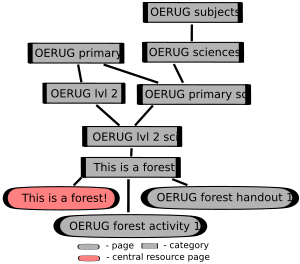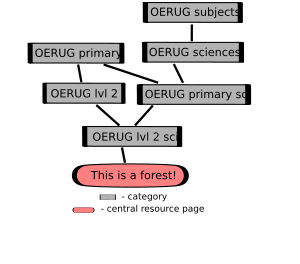Page categorisation
| Guideline | Every page in the wiki should be in at least one category. |
|---|---|
| Add'l info | |
| Examples |
Contents
Approvals
- I agree that all pages must be a part of at least ONE category should be used for this guideline. -- Peter Rawsthorne 15:15, 24 July 2009 (UTC)
Disapprovals
Discussion
This allows for every page to have connections to the other pages in the wiki. Pages that don't have categories are extremely difficult to find, and contents pages cannot be relied on. --Jesse Groppi 02:17, 15 July 2009 (UTC)
- I think we need to say more about this. I'm gathering from some of the other suggestions on categories, that categories are set up in a hierarchical framework. Maybe I knew this before, not sure. OK, let's say I'm creating a tutorial on OpenOffice.org Calc version 3 for beginners and there already exists tutorials on OpenOffice.org 2 for beginners and another Intermediate Calc version 2. My tutorial will have a main page, section subpages, and then content pages as subpages in each section. I'm now thinking that I should create a new category for OpenOffice.org Calc 3 beginner tutorial and put all of the pages in this category, and then include this category as a sub category of say Category:OpenOffice.org Calc, which would be a subcategory of OpenOffice.org. Right? I think a few examples in different situations will help users see how to implement this guideline on the pages that they make. Just some thoughts. --Alison Snieckus 16:10, 25 July 2009 (UTC)
- This is how I see what you're talking about being most logically organised:
Category:Open Office → Category:Open Office Writer
Category:Open Office Calc → Category:Open Office Calc 2 → Category:Julie's Open Office Calc 2 beginner tutorial → the pages for Julie's tutorial
Category:Alison's Open Office Calc 2 intermediate tutorial
Category:Open Office Calc 3 → Category:Alison's Open Office Calc 3 beginner tutorial → pages in Alison's tutorial
- Does that help make some sense of it? --Jesse Groppi 19:09, 29 July 2009 (UTC)
- Yup. I see that the structure includes different categories for the different versions of Calc. That makes sense to me. Using the new style guideline table that you are proposing, we can include a few examples like the one you created above to help users see how to implement this guideline. --Alison Snieckus 00:18, 30 July 2009 (UTC)
As we have discussed in other "forums", categorisation in WikiEducator is largely piecemeal and/or nonexistant. WE need more instruction on how to categorise. The WE tutorials have only a short bit on categories. I've done a bit of searching and that's all I've found. Should we make a help document? or an integrated guideline type page that discusses how to effectively implement the guidelines.
I'm asking this question because I think we need more in the Add'l Info and Examples section on this guideline, but there is SO much more to say (even with my limited experience with wiki categories) that I'm stymied as to what to include. What about including a link to a "how-to" page in the Add'l Info section?
For examples I suggest listing lots of different types of pages and what category they are in. Maybe something like the following: Categorize
- a user page according to countries of origin and residence, language fluency, user profession, user expertise, wiki skill level, WE awards, project paticipation.... See User:Einstein.
- a one-page content resource in the most highly relevant topic category. See [need a good example here].
- each page of a multi-page content resource in a category specific to the particular resource. See [need a good example here]. Assign the resource-specific category to be a sub-category of a more general category in that topic area.
- each page in a project in a category specific to the project. See [need a good example here]. Assign the project-specific category to be a sub-category of a more general category relating to the project.
- an uploaded image or file in...
I don't think the rule that every page must be categorised is going to be functional for educational content materials, for example a tutorial using a hierarchical structure of parent and child pages. I would recommend that the guideline propose categorising the home page or parent page, unless in situations where it makes logical sense to categorise the subpage (For example a lesson plan designed for teachers which has a self-contained handout for students as a sub-page of the lesson plan.) So for example, it makes sense to categorise Wikieducator_tutorial/What_is_a_wiki - but not, What_is_a_wiki/Advantages_and_disadvantages using the same category. Otherwise category pages will become cluttered with sub-pages of the same resource. --Wayne Mackintosh 21:22, 29 September 2009 (UTC)
Just some thoughts on what else to include here, --Alison Snieckus 16:13, 21 September 2009 (UTC)
- Examples like these are a fantastic idea, but I don't think it's feasible to give the best examples possible until we decide what structure we'd like the categories to be organised in. So perhaps we should hold on that until Workgroup:Categories/Proposed map is complete. --Jesse Groppi 18:58, 21 October 2009 (UTC)
Categorisation options
One issue WE need to address before WE can move forward on categories is how to handle multi-page content resources organised as subpages of a main parent page. The resolution of this issue impacts whether or not "All pages categorised" becomes a WE guideline.
Two options have been promoted:
1. Categorise all of the pages in a multi-page resource (the parent and all of its children) into a category specific to the resource. A simple example is a 10 page resource on forests created for level 2 students in Uganda. All of the pages in the resource (the one parent and the 10 children) would be categorised into something very specific to the resource, maybe OERUG level 2 life science--forests. This category would be sub-categorised into other categories: OERUG primary, OERUG life science, ... These categories would be sub-categorised into other categories: OERUG school, OERUG science, ...
(![]() : I recommend that any resource be given a unique title. This helps with differentiation between similar resources, and within categories. --Jesse Groppi 18:58, 21 October 2009 (UTC))
: I recommend that any resource be given a unique title. This helps with differentiation between similar resources, and within categories. --Jesse Groppi 18:58, 21 October 2009 (UTC))
Pros:
- All pages can be categorised with this scheme, which may enhance accessibility.
- if used in conjunction with OER metadata template, it's easy for authors to implement. An author's responsibility would be to 1) create a unique name for their resource and put it on the home (parent) page and every "member" page (could be automated if the resource uses a navigation template) and 2) add a completed metadata template to the main page. Category workgroup volunteers (or an automated system) would use the metadata to categorise the resource's unique category.
- adapted resources are copied to new parent and child pages and given a new unique category name; adaptation could be added as subcategory of original resource's category
- one-stop-shopping access to all of the pages in an individual resource
- does not preclude categorising particular subpages into other relevant categories, continuing with the example above: the page containing the OERUG level 2 forest handout is added to the category OERUG life science handouts.
Cons:
- to be specific enough to be unique among many potential resources of the same kind, the unique category name will often be redundant with higher level categories.
- long category names
- categories full of difficult-to-read subpage listings
- Works best for a resource of 10 - 20 pages. Larger resources would need to subcategorise further (OERUG level 2 life science--forests section 1). If smaller resources are more the norm, WE could end up with many categories of only 2-3 pages (less useful).
(![]() : Many of the cons can be resolved by using Extension:CustomCategory or a similar version that is customized by a We techie as suggested by Jesse. I don't think it is an experimental as Wayne suggested in the e-mail (just the link to the wikis using the extension). It is in a Stable Extension Category Rob Kruhlak 02:37, 21 October 2009 (UTC))
: Many of the cons can be resolved by using Extension:CustomCategory or a similar version that is customized by a We techie as suggested by Jesse. I don't think it is an experimental as Wayne suggested in the e-mail (just the link to the wikis using the extension). It is in a Stable Extension Category Rob Kruhlak 02:37, 21 October 2009 (UTC))
- (
 : It wasn't that the extension was experimental, rather that it could use some tweaking to work better at what it does, and to work better for WE --Jesse Groppi 18:58, 21 October 2009 (UTC))
: It wasn't that the extension was experimental, rather that it could use some tweaking to work better at what it does, and to work better for WE --Jesse Groppi 18:58, 21 October 2009 (UTC))
2. Categorise the home (parent) page of the multi-page resource into the most relevant categories.
- (
 : Note that resource subpages are not categorised. --Jesse Groppi 18:58, 21 October 2009 (UTC))
: Note that resource subpages are not categorised. --Jesse Groppi 18:58, 21 October 2009 (UTC))
Pros:
- Implementation of the OER metadata template on the main page could make categorisation something that authors don't have to do
- (
 : This is also possible with the above option --Jesse Groppi 18:58, 21 October 2009 (UTC))
: This is also possible with the above option --Jesse Groppi 18:58, 21 October 2009 (UTC))
- does not preclude categorising particular subpages into other relevant categories, same example as in option 1: the page containing the OERUG level 2 forest handout is added to the category OERUG life science handouts.
Cons:
- subpages could get lost (not sure this is true. Is there a tool that lists all the subpages of a page?)
- subpages may be largely uncategorised, making the use of the Special:UncategorisedPages utility less useful to the volunteers who help maintain WE's categorisation
- Possible over population of root or pseudo-root categories Rob Kruhlak 02:37, 21 October 2009 (UTC)
(![]() : not sure what you mean by pseudo-root, Rob --Jesse Groppi 18:58, 21 October 2009 (UTC))
: not sure what you mean by pseudo-root, Rob --Jesse Groppi 18:58, 21 October 2009 (UTC))
- I was thinking about a relatively general category that becomes popular (say via a cut and paste of the content info box or meta data template) and/or has no links up to root. A page this this is what I was imagining with regards to the Category:Wikieducator Tutorials.
My purpose for adding the above is to begin a collaborative effort to think through the various options on this issue. With that as the goal, please add additional options, add pros and cons for the different options, and make corrections as needed. --Alison Snieckus 01:40, 18 October 2009 (UTC)
WE tutorials example
Top down view:
Category:Tutorials → Category:WikiEducator → Category:Wikieducator Tutorials → Category:WikiEducator what is a wiki → Category:WikiEducator creating an account Category:Wikis → Category:Wikis what is a wiki → Category:WikiEducator what is a wiki → Category:Wikis creating an account → Category:WikiEducator creating an account
Bottom up view:
Category:WikiEducator what is a wiki ← Category:Wikieducator Tutorials ← Category:Tutorials ← Category:WikiEducator ← Category:Wikis what is a wiki ← Category:Wikis Category:WikiEducator creating an account ← Category:Wikieducator Tutorials ← Category:Tutorials ← Category:WikiEducator ← Category:Wikis creating an account ← Category:Wikis
| Proposed Guidelines | ||
|---|---|---|
| Style guide | ||
| Under discussion | Add new guideline | The use of capital letters | Acronyms in titles | Use of plurals | CSS classes | Boilerplates | Navigation templates | Language use | Transcultural word choice | Sub-categorisation | Page categorisation | Multiple categories | Category header | Spelling | Language Guidelines | |

